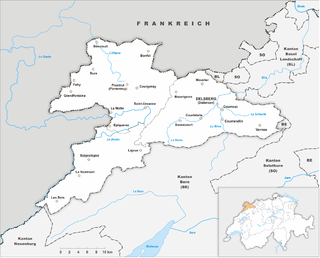
The Republic and Canton of Jura, less formally the Canton of Jura or Canton Jura, is the newest of the 26 Swiss cantons, located in the northwestern part of Switzerland. The capital is Delémont. It shares borders with the canton of Basel-Landschaft, the canton of Bern, the canton of Neuchatel, the canton of Solothurn, and the French régions of Bourgogne-Franche-Comté and Grand Est.

The Kinsky Horse is a Czech breed of warmblood sport horse. It was bred by the Kinsky family in the Kingdom of Bohemia, and is now one of four warmblood sport horse breeds reared in the Czech Republic, the others being the Czech Warmblood, the Slovakian Warmblood and the Moravian Warmblood. It was for many years absorbed into the Czech Warmblood; a separate stud-book was established in 2005. It is characterised by an unusual golden-yellow coat, though other colours are also seen.
The Foutanké or Fouta is a breed or type of light horse from Senegal, in West Africa. It results from the cross-breeding of a Fleuve stallion with an M'Bayar mare; its conformation is similar to that of the Fleuve. It is one of the four recognised Senegalese horse breeds – the others being the M'Bayar, the Fleuve and the M'Par – and is highly valued for horse-racing.
The Fleuve is a breed of horse from Senegal, in West Africa. Its name is the French word for "big river"; it is named for the Senegal River. It is one of four Senegalese horse breeds, the others being the Foutanké, the M'Bayar and the M'Par.
The M'Bayar is a breed of small horse from the historic region of Baol in Senegal, in West Africa. It is the most numerous of the four Senegalese horse breeds, the others being the Fleuve, the Foutanké and the M'Par.
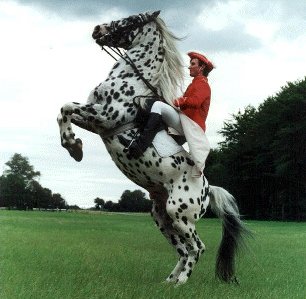
The Knabstrupper or Knabstrup is a Danish breed of warmblood horse. It is principally a riding horse, but is also used as a harness horse and as a circus animal.

Saignelégier is a municipality in the canton of Jura in Switzerland. It is the seat of the district of Franches-Montagnes. On 1 January 2009, the formerly independent municipalities of Goumois and Les Pommerats merged into Saignelégier.
Goumois was a municipality in the district of Franches-Montagnes in the canton of Jura in Switzerland. On 1 January 2009, the formerly independent municipalities of Goumois and Les Pommerats merged into Saignelégier.
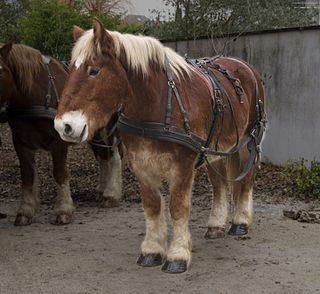
The Trait Breton is a French breed of draught horse. It originated in Brittany, in north-west France, from cross-breeding of local horses with various other breeds. It is strong and muscular, and often has a chestnut coat.
Franches-Montagnes District is one of the three districts of the canton of Jura, Switzerland. Its capital is the town of Saignelégier. The French-speaking district has a population of 10,479.
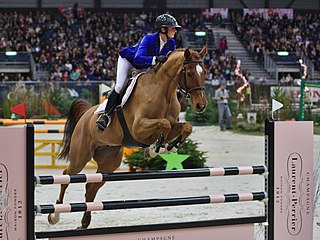
The Swiss Warmblood or Schweizer Warmblut is a modern Swiss breed of warmblood sport horse. It was created in the mid-twentieth century by merger of the Einsiedler – which had been bred for centuries at the Benedictine Monastery of Einsiedeln in the Canton of Schwyz – with the Swiss Halfblood and with traditional local breeds including the Ajoie, the Erlenbacher and the Entlebucher. It is sometimes known as the Neue Einsiedler. The Swiss Warmblood is bred at the Haras National Suisse at Avenches, in the Canton of Vaud.
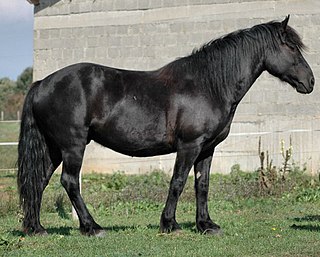
The Mérens, Cheval de Mérens or Caballo de Merens, still occasionally referred to by the older name of Ariégeois pony, is a small, rustic horse native to the Pyrenees and Ariégeois mountains of southern France, where the river Ariège flows, and northern Spain, near Andorra. Two general types, a small, light traditional mountain horse and a taller, sportier modern type, are found. Always black in color, Mérens must meet strict physical standards in order to be registered in the stud book. The breed is known for its sure-footedness on mountain terrain, as well as for its endurance, hardiness and docility. The French breed registry organizes regional offices, and partners with other national organizations in Europe to preserve and promote the breed. The organization enforces rigorous selection of breeding stock, with a goal of increasing quality in the breed. In the past, the Mérens was used for farm work, draft work and as pack horses. Today it is mainly used as a saddle horse, although some members of the breed have been successful in carriage driving. Many Mérens are taken on an annual transhumance, in which they are moved higher in the mountains during the summer and into the valleys for the winter. An old practice, it fell into disfavor, but has recently re-emerged.

The Poitevin or Poitou is a French breed of draft horse. It is named for its area of origin, the former province of Poitou in west-central France, now a part of the region of Nouvelle-Aquitaine. It was formed in the seventeenth century when horses of Flemish or Dutch origin, brought to the area by engineers working to drain the Marais Poitevin, interbred with local horses. Although it has the size and conformation of a draft horse, the Poitevin has never been bred for draft abilities, and has been little used for draft work. Its principal traditional use was the production of mules. Poitevin mares were put to jacks of the large Baudet du Poitou breed of donkey; the resulting Poitevin mules were in demand for agricultural and other work in many parts of the world, including Russia and the United States. In the early twentieth century there were some 50,000 brood mares producing between 18,000 and 20,000 mules per year.

The Anglo-Norman horse is a warmblood horse breed developed in Lower Normandy in northern France. A major center of horse breeding, the area had numerous regional types that were bred to one another and then crossed with Thoroughbreds to form the Anglo-Norman. Various body types developed within the Anglo-Norman breed, two of which were split off to form the Norman Cob and French Trotter. The remaining types were eventually standardized, although there remained some criticism of the "hybrid" nature of the breed's conformation. However, it is successful as an international sport horse, especially in the sport of show jumping. The Anglo-Norman also contributed to the development of several other breeds in Europe and Asia.
Franches-Montagnes may refer to:

The Capra Grigia, French: Chèvre grise des montagnes, German: Graue Bergziege, is a rare and endangered indigenous breed of domestic goat from Switzerland. It originates in the valleys of the cantons of the Grisons or Graubünden in the eastern part of the country, and of Ticino or Tessin in the south. It is possibly related to the grey type of the Passeirer Gebirgsziege from the Autonomous Province of Bolzano in north-eastern Italy.
The M'Par or Mpar is a breed of small horse from the historic region of Cayor in Senegal, in West Africa. It may for that reason be called the French: Cheval de Cayor. It is the smallest of the four Senegalese horse breeds, the others being the M'Bayar, the Fleuve and the Foutanké.
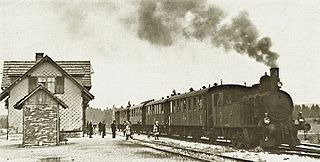
The Régional Saignelégier–Glovelier (RSG) was a railway company that operated a metre-gauge railway from Saignelégier to Glovelier in Switzerland. In 1944, the railway was merged to form the Chemins de fer du Jura (CJ), which converted the line to metre gauge and electrified it at 1500 Volt DC. Today, the line is part of the La Chaux-de-Fonds–Glovelier line.

The Saignelégier–La Chaux-de-Fonds Railway was a railway company that operated a metre-gauge railway from Saignelégier to La Chaux-de-Fonds in western Switzerland. In 1944, the railway was merged to form the Chemins de fer du Jura (CJ), which electrified it at 1500 Volt DC in 1953. Its line is now part of the La Chaux-de-Fonds–Glovelier line.















